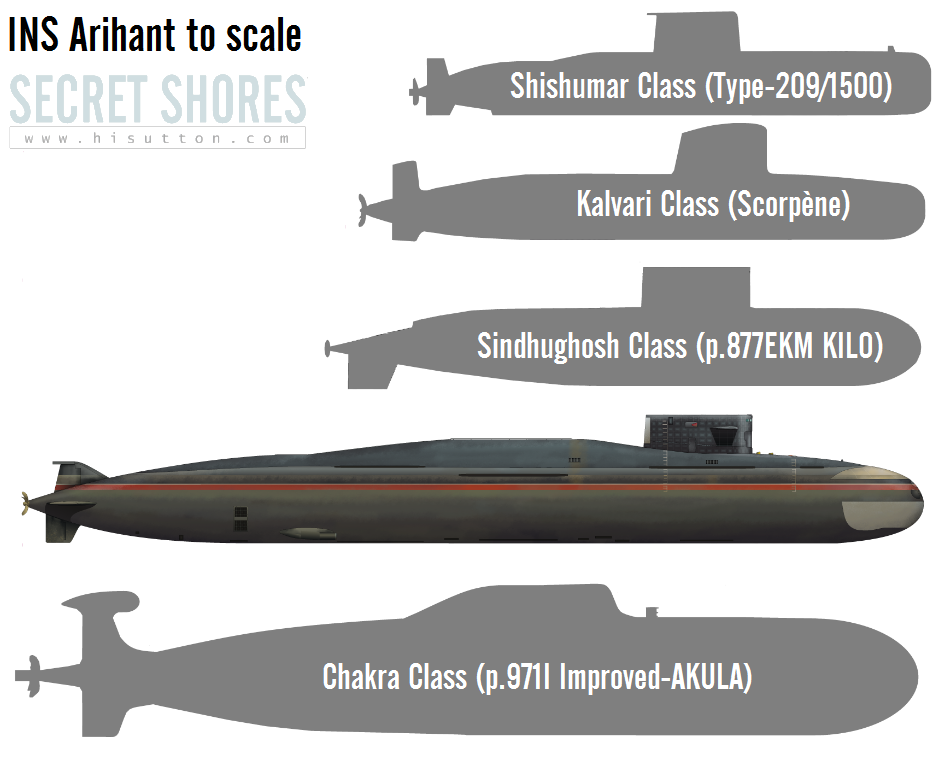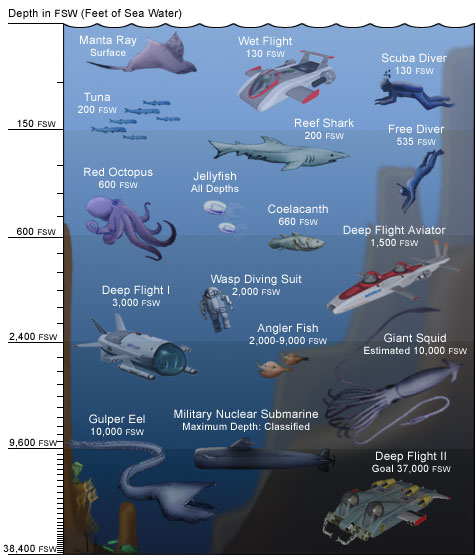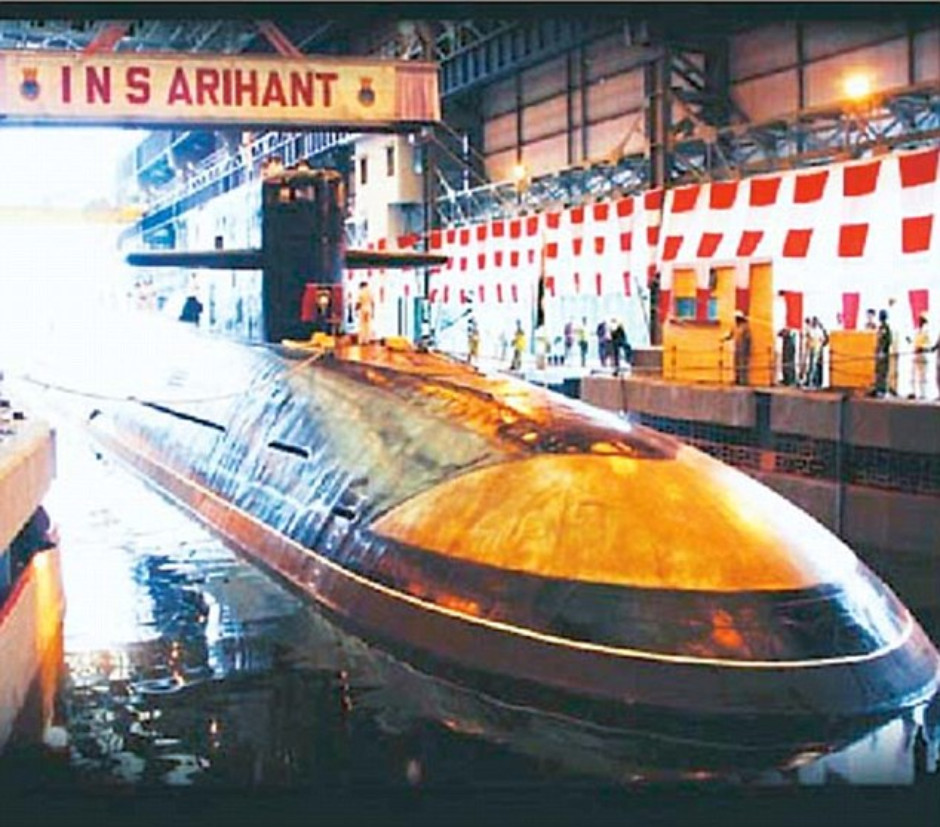Here is an very Interesting Review of the INS Arihant.
H I Sutton - Covert Shores
Observations:
From the couple of decent photographs of the boat with both show the starboard quarter (front right), we can deduce that the forward section of the hull is based directly upon the Russian KILO Class diesel attack submarine. India operates 9 Soviet built
Project-877EKMKILO as the
Sindhughosh Class. The upper sonar casing and torpedo tube arrangement look to be identical. The sail is also essentially similar although necessarily raised slightly because the casing gets deeper as it goes aft to accommodate the main missile silos. The forward hydroplanes are remounted on the sail rather than on the forward casing, which also entails minor rearrangements, but overall the sail can be said to be the same hat of the KILO. It features an open bridge at the top, a bad-weather bridge with windows and a sonar array in the forward part of the sail. The distance from the bow to the sail is also the same as on he KILO, another telling observation.
So the forward hull is essentially that of the KILO design. There are six torpedo tubes which have to be reloaded through the top two from a platform which extends out of the forward hull. The torpedo room will be on the upper deck immediately behind the torpedo tubes and in front of the sail. Following the KILO layout, the top two tubes are likely configured for wire guided torpedoes (e.g. TEST-71ME-NK) and the lower four for self-guiding rounds (e.g. 53-65K). The lower tubes are reloaded using a fast automated reloading system. Eighteen torpedoes can be carried in total, although patrols probably occur with fewer. Although conceivably possible, it is unlikely that Arihant is equipped to fire KLUB cruise missiles or other exotic weapons through her torpedo tubes. As a nuclear deterrent she would not be utilised to lunch conventional cruise missile attacks during a war and would only carry torpedoes as a means of self defense.
Beneath the torpedo tubes is a large sonar dome designed for a circular sonar such as the CIM-400E "Rubicon-M" (SHARK TEETH) fitted the Sindhughosh Class. Behind this the main pressure hull starts, which is divided onto three floors. Like other Russian designs the KILO is a double-hull design which means the pressure hull is encased in an outer hull. This allows the reinforcing frames to be on the outside of the pressure hull. Beneath the sail is the control room.
Pocket boomer
Arihant is about 30% longer than the KILO with a reported length of 110m. The reason is that there are two additional sections inserted behind the sail, the first being the missile section for Submarine-launched ballistic missiles (SLBNs). It has to be at least 11m from keel to the top of the casing to accommodate the 10m long ballistic missiles. The depth of the missiles necessitates the hunchback appearance which is characteristic to SSBNs. This section is also likely to include maintenance space and ballast tanks to take in water to compensate for the weight of the missiles when they are fired. Behind this is the second additional section containing the reactor. This section requires control stations and heavy lead radiation shielding so it is probably a 'plug in' hull section with only a tunnel connecting the forward compartments with the extreme aft just like on Western nuclear submarines. We can also guess that this section would have a large water intake mounted beside it to allow the secondary cooling loop to operate without pumps within certain performance envelopes. Behind it will be the steam turbine, electric motors and auxiliary diesels. The tail of the boat is open to speculation but most depictions show a conventional cruciform tail rather than the KILO's distinctive rudder arrangement which has a large fin underneath and no vertical fin on top. I have illustrated the aft fin configuration on relatively recent Russian designs including a towed array tube built in to the upper fin. The result is a very long boat which is much bigger than the diesel-electric attack submarines in Indian service, and similar in length to the much heavier Akula Class boat loaned from Russia:

Compared to other SSBNs however she is considerably smaller and thus more lightly armed. The standard fit is either:
- 12 x K-15 Sagarika SLBNs (700km range, 1,400km with reduced warhead) < Nuclear capable Or/
- 4 x K-4 SLBNs (3,500km range) < Assumed nuclear equipped
Note that the K-15 is a smallish single warhead missile which is viewed as an interim solution. Because of its small diameter three tubes can be fitted within the space for a single K-4 missile tube, hence the 12 missiles in total. Individually the K-15 is loosely equivalent to the first generation Soviet SLBNs except that it is far more compact and can be fired from underwater making it a much better system (as you'd expect fifty years on!). But it is far less potent than other modern SLBNs in service. It does not have MIRVs (multiple independent re-entry vehicles) so measured in number of warheads the gap to other SLBNs is even greater, which is where the K-4 SLBN comes in to the equation. This is similar in size and range to other SLBNs and can apparently carry MIRVs. The range makes a big deal; with the K-15 missile Arihant would have to be somewhere in the Arabian Sea in order to threaten Karachi, well within the reach of the Pakistani Navy. Whereas with the K-4 it could be somewhere in the Bay of Benghal which is almost the Indian Navy's private sea.
Only four can be carried however, which again is many fewer than other active SSBNs:
- Type-092 Class, China 12 x JL-1A SLBNs(2,500km range) (Considered obsolete)
- Type-094 Class, China 12 x JL-2 SLBNs(8 to 14,000km range)
- Triomphant Class, France 16 x M51 SLBNs(8 to 10,000km range)
- Borei Class, Russia 16 x RSM-56 Bulava SLBNs (10,000km range)
- DELTA-III Class, Russia 16 x SS-N-18 STINGRAY SLBNs (6,500km range)
- DELTA-IV Class, Russia 16 x SS-N-23 SKIFF SLBNs (9,300km)
- Vanguard Class, UK 16 x Trident-II D5 SLBNs (7,000 to 12,000km range)
- Typhoon Class, Russia 20 x RSM-56 Bulava SLBNs (10,000km range)
- Ohio Class, USA 24 x Trident-II D5 SLBNs (7,000 to 12,000km range) All range stats require a pinch of salt
Maybe the Indian Navy has done something very clever indeed by sacrificing the number of missiles carried. There is a school of thought that nuclear wars can be won, and that the country who lobs the most missiles wins. There is another school of thought that nuclear war is
mad and cannot be won, but in order to ensure this is true a deterrence must be sufficiently weighty to convince a crazy enemy that the war is unwinnable. By either school of thought Arihant is at a disadvantage. But Arihant's deterrent isn't pointed at USA or Russia, it is pointed at Pakistan and to an extent China and possibly any middle eastern countries who might tool-up in the near future. The bulk of India's nuclear deterrent is land based (as is China's and Pakistan's) so the Arihant is merely a diversification of capabilities which supplements the main force. In addition to this, nuclear bombs are expensive and slow to produce so, combined with the need to test technologies it is economical to only fit four tubes. More than enough to guarantee the destruction of several cities.
The reduction in war load also allowed the use of the smaller KILO class hull which again was a risk reduction. The question will be how many more Arihants will enter service? At least four will be required to maintain a constant at-sea vigilance. But if India wants to switch it up to 'full capability' SSBNs they'll need to start building a completely new design with all the costs and delays that is likely to entail.














 .
.





